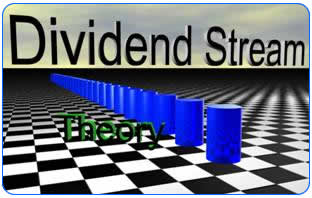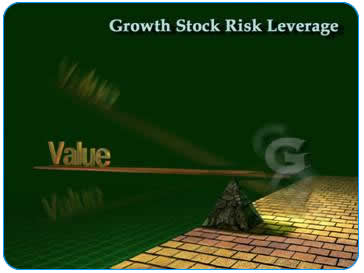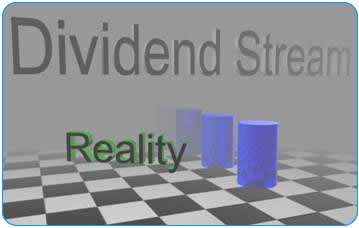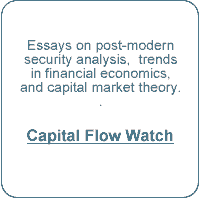Essay on Investment Theory
The Value of Dividends
A cow for her milk
A hen for her eggs,
And a stock, by heck,
For her dividends.
An orchard for fruit,
Bees for their honey,
And stocks, besides,
For their dividends
The concept of calculating the present value of dividends had been carefully explored and defined many years before there were Nobel prizes awarded in economics.
In 1938, John Burr Williams published a paper (The Theory of Investment Value, John Burr Williams, Harvard University Press, 1938) showing that ordinary financial formulas could be used to calculate the value of common stock by discounting the future stream of dividends.
These equations were similar to those used in valuing annuities.
Over the years, many pages of abstruse mathematics have expanded on John Burr Williams' concept.
However, the basic idea can be captured in a single equation.
 During the Great Depression, John Burr Williams related the value of stock to the future stream of dividends.
During the Great Depression, John Burr Williams related the value of stock to the future stream of dividends.Williams and his followers said that a stock was worth the present value of its future stream of dividends.
This dividend stream might be assumed to be infinite, since corporations could live forever.
Plugging in the value of the current dividend 'D', and assuming that this dividend grows at a constant annual rate 'G', and discounting this cash flow at a hoped-for interest rate 'I', the stock value would be calculated by the formula:
Value = D / (I – G)
Variations on this formula have been developed for changing patterns of growth, fluctuating interest rates, myriad risk factors, and for less-than-infinite streams of dividends.
The formula works only when the interest rate is equal or greater than the projected rate of growth.
Williams' formula works as long as the interest rate is equal or greater than the rate of growth.
Otherwise, the value becomes infinitely large – a strange mathematical result known as the Petersburg Paradox.
The value for 'I' – the interest rate used in this equation – is not the interest on loans or bonds, but rather the return that the investor would expect, considering market alternatives at the time.
Calculating Discounted Present Value
The picture illustrates the concept of a dividend stream stretching off into infinity (represented by the blue glass pegs).
 Williams imagined theoretical dividends streaming off into infinity.
Williams imagined theoretical dividends streaming off into infinity. To show how to determine the interest rate in the formula, let us assume that a company has a thirty-year bond trading at a current yield of nine percent.
Our investor might reasonably demand a higher yield of, say, eleven percent on the ordinary stock.
To our grandfathers, it seemed reasonable to demand a higher yield on stock than on bonds.
After all, the nine percent yield on the company bonds represents a contractual duty, whereas dividends on common stock do not.
Besides, the coupons on the bond are paid in preference over any distribution to stockholders.
The next problem we have in using this formula is to decide the projected rate of growth, 'G'.
Please note: this is the rate of growth of dividends, not earnings.
Obviously, the idea of projecting a stream of dividends into infinity is ridiculous, but we will pretend we are economists and ignore this for now.
Plugging Into The Formula
To explain the formula, let us say that Mr. Dividend thinks that the company, now paying dividends of ten dollars a share, will continue to do so forever and that dividends will increase three percent a year.
At a personal discount rate of eleven percent, the value of the stock would be:
$ 10.00 / (.11 – .03) = $ 125
In this case, the current dividend yield on the stock would be eight percent – lower than the nine percent yield on bonds of the same company.
What Williams' Formula Implies
The less the difference between an investor's target return and dividend growth, the greater the stock value.
A decline in an investor's targeted returns and rising growth expectations increases the present value of this infinite dividend stream.
Holding constant the target return of eleven per cent, the following table shows how this stock value changes for different estimates of dividend growth:
| Estimated Dividend Growth | Approximate Stock Value (11% return) | Approximate Current Dividend Yield |
|---|---|---|
| 10 % | $ 1,000 | 1 % |
| 9 % | $ 500 | 2 % |
| 8 % | $ 333 | 3 % |
| 7 % | $ 250 | 4 % |
| 6 % | $ 200 | 5 % |
| 5 % | $ 166 | 6 % |
| 4 % | $ 142 | 7 % |
| 3 % | $ 125 | 8 % |
| 2 % | $ 111 | 9 % |
| 1 % | $ 100 | 10 % |
| 0 % | $ 90 | 11 % |
The table shows that the higher the expected rate of growth, the greater the expected volatility in stock values because a small variation in estimated growth makes a big difference in the value of a stock.
High expectations of growth results in sacrificing current yield.
In the example, when the growth projection of ten percent falls to nine percent, the stock value is cut in half as long as the target return stays at eleven percent.
On the other hand, when the growth projection falls from one percent to zero, the value of the stock drops only ten percent.
Also, higher estimates of growth result in higher values, lowering the current dividend yield.
Because our investor could buy bonds of this company yielding nine percent, he would sacrifice current yield if he were to pay five hundred dollars a share in the hope that return from future dividends might yield a theoretical eleven percent.
Why Growth Stocks Are Risky
If – after buying a stock – our investor's expectation for dividend growth falls from ten to nine percent, the stock value would drop by half and the long-term yield would be lower than planned.
Over-estimating growth can be very costly.
Even worse, the current dividend yield would be only two percent.
The investor would have done better by holding company bonds.
Similar wild swings will occur when Mr. Dividend changes his personal discount rate, influenced by variations in bond prices.
So, despite a mathematical basis for value, problems arise when we try to put numbers into the formula.
Even if our investor had perfect information that he could use today to predict the dividend stream, it is certain that this information and, consequently, expected growth rates will change over time.
 Small changes in estimated rate of growth result in much bigger changes in theoretical value.
Small changes in estimated rate of growth result in much bigger changes in theoretical value.There is simply no way to predict future dividend streams accurately.
Thus, the theoretical value of the stock must rise and fall.
From this we can infer that the greater the expected growth of dividends, the greater the risk to the investor.
Growth stocks are riskier than companies with less exciting prospects.
Since it is certain that expected growth expected rates will rise and fall, it is certain that growth stocks are riskier than companies with less exciting prospects.
In other words, it seems reasonable that a prudent investor – to compensate for risk – should use a higher personal discount rate when evaluating growth stocks than when calculating the worth of companies with limited growth prospects.
Is Growth Worth A Premium?
Let us say that Company Alpha, expected to grow yearly at ten percent, has bonds yielding six percent. Company Beta is expected to grow at three percent and has similar bonds with the same yield.
- An investor might discount the dividend stream of Company Beta at three percentage points above the bonds to compensate for the non-contractual nature of dividends.
- For Company Alpha, the investor might use a discount rate five or six percentage points above the bonds because of greater volatility associated with growth stocks.
For growth stocks, most cash return is deferred and may never be received.
When a stock is priced to yield high current cash return, the investor receives his return faster and with more certainty than when growth of future dividends is a large part of the value.
For growth stocks, most cash return is deferred and may never be received. Higher volatility and tentative, deferred dividends explain why Mr. Dividend does not like to pay a premium for growth stock.
In another essay (Mr. Clendenin's Suggestion), we see how we might vary the discount rate for dividends that are further removed in time.
A Foggy Cash Flow
The problem with the mathematical approach to stock value is that it requires that we predict the future accurately.
Most corporations do not make financial projections that extend more than three to five years.
Even one year projections are inaccurate.
The fog of the unknowable descends quickly over any forecast, leaving us with no guide as to what the long-term dividend stream might be.
The picture shows how the blue glass pegs representing the stream of dividends appear in the real world.
 The fog of the unknowable quickly descents over any projected cash flow.
The fog of the unknowable quickly descents over any projected cash flow.Non-contractual Cash Flows
Another problem with stock value theory is that the idea was borrowed from bond and annuity formulas – examples of contractual cash flows.
Common stock gives the owner no assurance that dividends will ever be paid, even if the company is profitable.
At the turn of the century, Microsoft was a profitable company, but for over a generation, shareholders received no dividends.
Only controlling shareholders have access to corporate cash flows.
Using Williams' formula, Microsoft stock would be worth nothing!
The argument that retained earnings 'belong' to shareholders is misleading, since it is only the controlling shareholders who have access to these assets.
To invest in common stocks requires the utmost confidence in company management. Would you give someone your retirement money if they made the following proposal?
I'll keep your money for you and send you an audited report on how much is left each year. Although I may never give you your money back, it still belongs to you.
I may use it to travel around the world and live in luxury, as I please. Somebody else, who you don't know, will be taking care of your money five or ten years from now and will have the same advantages I have.
However, you may always sell your rights of ownership to anyone you like, maybe for a profit.
This seems like an absurd suggestion, but it is the deal offered to public shareholders by those who control most companies listed on the stock exchanges of the world.
This explains why Mr. Lesser Fool looks like Mr. Greater Fool.
Two Insurmountable Barriers
There have been many attempts to wring some meaning out of John Burr Williams' equation, using complex mathematical techniques to deal with the Petersburg Paradox and the unknown.
Companies are not obligated to pay anything to stock investors and the future is unknowable.
However, in every case we run up against two insurmountable barriers: the future is unknowable and the company is not obligated to pay anything to stock investors, even if the business is profitable.
How can we discount a future stream of dividends when the company has no legal duty and little incentive to pay dividends?
What is the investor to do when dividends go out of fashion, as in the last decade of the Great Bubble?
Dividends – Oh How We Loved Ye
Common stocks were initially an instrument for speculators and adventurers.
Gradually, over many generations, ordinary people came to regard stocks as sound, conservative investments.
Finally, uncritical acceptance of the Common Stock Legend led to excess, until equities were again speculative – although many did not recognize the change.
Monarchs sanctioned the first corporations in the early seventeenth century for purposes of trade, exploration, and colonization.
The East India Company paid dividends of from 95% to 234%.
The East India Company, The Virginia Company, and The Muscovy Company were among the early stock enterprises.
- These early, high-risk ventures had licenses for limited periods and for specific ends.
- The number of shareholders (often actually called 'adventurers') was small.
- The investors, however, expected high dividends by today's standards.
- Subscribers tied up capital in these ventures for six to eight years.
The first nine voyages of The East India Company produced dividends in cash and spices ranging from ninety-five percent to two hundred thirty-four percent on the investment. ('Casebook in American Business History', N.S.B. Gras and Henrietta M. Larson, F.S. Crofts & Co. 1939, New York.)
Nineteenth Century Commonsense
By the early nineteenth century, common wisdom was that sensible investments consisted of bonds and real estate.
The reasons were obvious:
Real estate and bonds can provide a regular stream of income.
- real estate was tangible property that could yield income; and
- bonds were contractual obligations to pay income, often backed by tangible property.
Both real estate and bonds could provide a regular stream of cash from which one could pay living expenses.
In the nineteenth century, financial disclosure was spotty.
Because of high returns from dividends and the tendency to invest in simple enterprises led by people of established reputation, careful investors could apply funds in a diversified portfolio of stocks with reasonable assurance.

